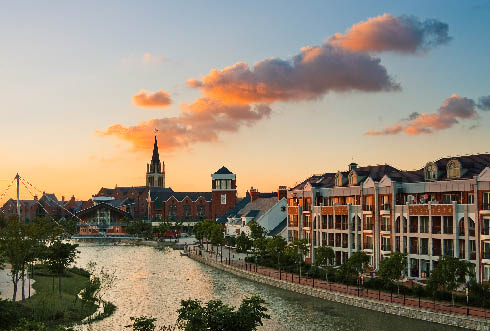By WU MEILING


| Newsmore | ||||||
|
| Culturemore | ||||||
|
| Tourismmore | ||||||
|
| Economymore | ||||||
|
| Lifemore | ||||||
|
| Around Chinamore | ||||||
|
| Around China |
| Songjiang, Arts and Romance By WU MEILING
 SONGJIANG District in the southwest of Shanghai came into being long before the city itself emerged. Locals therefore compare its relationship to the city as that of an heirloom jade pendant on the chest of a baby (traditionally a present from elder family members as blessing for newborns), or a seal on a masterpiece painting, reminding all of its provenance and giving it an identity. Merely 30 kilometers from downtown Shanghai, the district’s idyllic grace distinguishes it from the dominant glass-and-steel cityscape of the modern metropolis. Emerging from Metro Line 9, which links Songjiang with the downtown, many visitors with big city clamor still ringing in their ears find themselves standing in a very different world – a land of intertwining rivers with rolling mountains on the skyline. The scene is a balm to restless souls long stressed by the pace of the international industrial and commercial center. Nature and History The beautiful scenes in Songjiang have spawned many romantic nicknames. The best known is Yunjian, meaning amid clouds. A story in wide circulation is that during their first meeting Lu Ji and Xun Minghe, both talented scholars of the Jin Dynasty (265-420), tried to outdo each other in giving an unusual self-introduction. Xun spoke first: “I am Xun Minghe under the sun (Xun is from the capital city. As the emperor is referred to as the sun, the city of his residence was often called “under the sun”). Lu, a Songjiang native, immediately replied: “I am Lu Ji amid clouds.” The fertile lands, dense woods and steep valleys of Songjiang were home to a good variety of wild life in the past, and this gave rise to other names for it, such as Rongcheng (city of buckhorn), Luxiang (town of weever fish) and Gushui (valley water). In 219 during the Three Kingdoms Period, the title Huating Marquis was conferred on General Lu Xun of the Wu Kingdom for his outstanding military feats, and he received the area centered on Songjiang as his fiefdom. The region was therefore named Huating till the Yuan Dynasty (1271-1368), when it was renamed Songjiang and promoted to prefecture status, while Shanghai had just been established as a subordinate county. In the Ming Dynasty (1368-1644) Song-jiang Prefecture had expanded to constitute Shanghai and parts of neighboring Jiangsu and Zhejiang provinces. With a history stretching back to the Qin Dynasty (221-206 BC), Songjiang has a rich heritage of historical sites. Its top attractions include the Huzhu Tower that inclines even more than the Leaning Tower of Pisa, Sheshan Catholic Church, Square Pagoda of the Northern Song Dynasty (960-1127), Sutra Stupa of the Tang Dynasty and the Guangfulin Village Ruins of the Spring and Autumn Period (770-476 BC), all evidence of the region’s splendid past. There are 12 ancient pagodas in Shanghai, five of them in Songjiang. The biggest is the Sutra Stupa of the Tang Dynasty. Built in 859, its stone structure is carved with the Dharani sutra. It’s said the stupa was erected on top of a well that was believed to be the eye of the sea, in order to prevent the tides from bringing evils to local residents. When touched by the last glow of the sun, the clouds, flora, animals and human images in relief on the 21-tier tower look animated, the epitome of stone-carving craftsmanship. The images are plump, and the lines terse and smooth, both characteristic of Tang arts. Its crowning glory is the relief carving atop the tower depicting a princess and entourage progressing to the temple. A maid holding a prayer banner leads the group, and the young royal follows, flanked by two more maids. Around them are deities of various ranks. The mortals and immortals add up to 16, each with lifelike expressions and different postures. More than a thousand years have passed since its creation, and the stupa silently but staunchly clasps a piece of history and keeps it from being swallowed up in the onrush of time. The Sutra Stupa stands as a tangible connection between the present and the past. |
| VOL.59 NO.12 December 2010 | Advertise on Site | Contact Us |